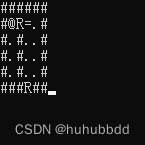[USACO11OPEN]Corn Maze S
题面翻译
奶牛们去一个 N × M N\times M N×M 玉米迷宫, 2 ≤ N ≤ 300 , 2 ≤ M ≤ 300 2 \leq N \leq 300,2 \leq M \leq300 2≤N≤300,2≤M≤300。
迷宫里有一些传送装置,可以将奶牛从一点到另一点进行瞬间转移。这些装置可以双向使用。
如果一头奶牛处在这个装置的起点或者终点,这头奶牛就必须使用这个装置。
玉米迷宫除了唯一的一个出口都被玉米包围。
迷宫中的每个元素都由以下项目中的一项组成:
- 玉米,
#表示,这些格子是不可以通过的。 - 草地,
.表示,可以简单的通过。 - 传送装置,每一对大写字母 A \tt{A} A 到 Z \tt{Z} Z 表示。
- 出口,
=表示。 - 起点,
@表示
奶牛能在一格草地上可能存在的四个相邻的格子移动,花费 1 1 1 个单位时间。从装置的一个结点到另一个结点不花时间。
题目描述
This past fall, Farmer John took the cows to visit a corn maze. But this wasn’t just any corn maze: it featured several gravity-powered teleporter slides, which cause cows to teleport instantly from one point in the maze to another. The slides work in both directions: a cow can slide from the slide’s start to the end instantly, or from the end to the start. If a cow steps on a space that hosts either end of a slide, she must use the slide.
The outside of the corn maze is entirely corn except for a single exit.
The maze can be represented by an N x M (2 <= N <= 300; 2 <= M <= 300) grid. Each grid element contains one of these items:
* Corn (corn grid elements are impassable)
* Grass (easy to pass through!)
* A slide endpoint (which will transport a cow to the other endpoint)
* The exit
A cow can only move from one space to the next if they are adjacent and neither contains corn. Each grassy space has four potential neighbors to which a cow can travel. It takes 1 unit of time to move from a grassy space to an adjacent space; it takes 0 units of time to move from one slide endpoint to the other.
Corn-filled spaces are denoted with an octothorpe (#). Grassy spaces are denoted with a period (.). Pairs of slide endpoints are denoted with the same uppercase letter (A-Z), and no two different slides have endpoints denoted with the same letter. The exit is denoted with the equals sign (=).
Bessie got lost. She knows where she is on the grid, and marked her current grassy space with the ‘at’ symbol (@). What is the minimum time she needs to move to the exit space?
输入格式
第一行:两个用空格隔开的整数 N N N 和 M M M。
第 2 ∼ N + 1 2\sim N+1 2∼N+1 行:第 i + 1 i+1 i+1 行描述了迷宫中的第 i i i 行的情况(共有 M M M个字符,每个字符中间没有空格)。
输出格式
一个整数,表示起点到出口所需的最短时间。
样例 #1
样例输入 #1
5 6
###=##
#.W.##
#.####
#.@W##
######
样例输出 #1
3
提示
例如以下矩阵, N = 5 , M = 6 N=5,M=6 N=5,M=6。
###=##
#.W.##
#.####
#.@W##
######
唯一的一个装置的结点用大写字母 W \tt{W} W 表示。
最优方案为:先向右走到装置的结点,花费一个单位时间,再到装置的另一个结点上,花费 0 0 0 个单位时间,然后再向右走一个,再向上走一个,到达出口处,总共花费了 3 3 3 个单位时间。`
题解:
#define _CRT_SECURE_NO_WARNINGS
#include <iostream>
#include <map>
#include <queue>
#define pii pair<int,int>
using namespace std;
int N, M, sx, sy, dx[4] = { -1,0,1,0 }, dy[4] = { 0,1,0,-1 };
char a[301][301]; bool vis[301][301] = { 0 };
struct Teleport {
int x1, y1, x2, y2, sum;
Teleport():sum(0) {}
pii get_partner(int x, int y) {
if (x == x1 && y == y1)
return { x2,y2 };
else
return { x1,y1 };
}
}t[26];
struct Node {
pii p; int steps;
Node(pii pp, int st) :p(pp), steps(st) {}
};
int bfs() {
queue<Node> q;
q.push(Node({ sx, sy }, 0));
vis[sx][sy] = 1;
while (q.size()) {
int curx = q.front().p.first, cury = q.front().p.second, step = q.front().steps;
q.pop();
for (int i = 0; i < 4; i++) {
int tx = curx + dx[i], ty = cury + dy[i];
if (tx > 0 && ty > 0 && tx <= N && ty <= M && a[tx][ty] != '#' && !vis[tx][ty]) {
if (a[tx][ty] >= 'A' && a[tx][ty] <= 'Z') {
pii temp = t[a[tx][ty] - 'A'].get_partner(tx, ty);
q.push(Node(temp, step + 1));
vis[tx][ty] = 1;
}
else if (a[tx][ty] == '=') {
return step + 1;
}
else if (a[tx][ty] == '.') {
q.push(Node({ tx,ty }, step + 1));
vis[tx][ty] = 1;
}
}
}
}
return -1;
}
int main()
{
//freopen("IN.txt", "r", stdin);
cin >> N >> M;
for (int i = 1; i <= N; i++) {
for (int j = 1; j <= M; j++) {
cin >> a[i][j];
if (a[i][j] >= 'A' && a[i][j] <= 'Z') {
if (t[a[i][j] - 'A'].sum == 0)
t[a[i][j] - 'A'].x1 = i, t[a[i][j] - 'A'].y1 = j, t[a[i][j] - 'A'].sum++;
else
t[a[i][j] - 'A'].x2 = i, t[a[i][j] - 'A'].y2 = j, t[a[i][j] - 'A'].sum++;
}
else if (a[i][j] == '@') {
sx = i, sy = j;
}
}
}
cout << bfs();
return 0;
}
bfs的思路不想说了,这题主要坑了我两点:
-
传送门不一定只使用了一次,考虑一种极端的情况:

在这种情况下,走寻常路已经无路可走,必须通过传送门中转一下才能到达出口,最短时间为4。 -
如何让传送门多次使用而不重复?
既然可能多次使用传送门,就不得不思考传送门到底能用多少次。上图的例子其实已经说明,传送门最多只能使用两次,一种是通过传送门跳到下一个离出口更近的点,这种情况传送门用一次就够了;另一种则是just路过一下传送门,这种情况传送门就要用两次,因为踩到传送门就必须传送。。。走个过场也要踩个两回。
但是仅仅用次数就能判断吗,简单的对每一对传送门计数,超过2次就不可用了吗?不!

这是张很有意思的图,从起点出发,上右下左都可走,但是现在我们先只看上和右的情况。如果向上走,那么要想走到终点,肯定要踩传送门,于是传送门被使用了一次,另一个传送门的位置入队。
然后按照bfs顺序,这时候应该去访问右边,而不是顺着传送门继续走。
向右走的话,那么要想走到终点,肯定又要踩传送门,于是传送门又被使用了一次。
至此,传送门已经使用了两次,不能再用了,但是队列里还有两个对面传送门的结点,而且这两结点也没用了,因为这对传送门已失效,回不来了。显然是不合理的。
我的想法是,既然上和右是等效的,那只走其中一个就好了嘛
所以,传送过去的时候,我给传送起点标记已访问,终点不标记,方便它传回来,这样右的情况就访问不了传送起点。然后传送回来的时候,这时候原来的传送终点变成起点了,我再把这个起点标记已访问,至此,这个传送门就已完成它的使命。
然后除了这两个坑点,再浅说一下怎么查询传送门的坐标:
- 先明白一点,‘B’=‘A’+1,‘C’=‘A’+2…‘Z’=‘A’+25,这是通过ASCII码值来计算的,设计一个结构体,里面存放每对传送门的两个坐标。
- 然后创建一个大小为26的结构体数组,通过ASCII码值就可以实现随机存取啦,而且使用的空间还是常数阶的。比如,数组名为t,则要查询’B’号传送门,则直接用t[‘B’-‘A’]就能够实现了。





















 185
185











 被折叠的 条评论
为什么被折叠?
被折叠的 条评论
为什么被折叠?








